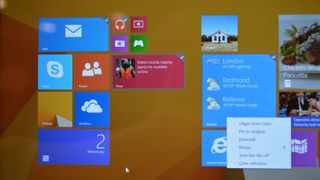Windows 7 vs Windows 8.1: which is the better OS?
For business or personal use, which OS is better?
Mac attack
The debate about which operating system to choose is, however, never complete without comparing Windows to its biggest rival, Apple's Mac OS X. Over recent years, the Mac ecosystem – both hardware and software – has come on leaps and bounds, introducing features that surpass Microsoft's own.
The "Back to Mac" strategy unveiled by Apple means that features found on iOS are becoming available on the Mac, creating a synergy between the two platforms. While the concept may sound similar to Microsoft's strategy with Windows 8.1 and Windows Phone, the two operating systems remain distinctly different: different code bases, no touchscreen input for OS X, and no app sharing (beyond namesakes). Even though this will all change once Windows 10 is out, the attitude towards the differences between Windows 8.1 and Windows Phone could remain raw for some time.
In enterprise, Microsoft's offering beats Apple's hands-down. While the Office suite is available on Mac, there are a host of apps that many businesses rely upon to get the job done that are not available for OS X and likely never will be.
The refusal to license OS X onto machines not manufactured by Apple dealt them a deadly blow in the enterprise space, where companies are more comfortable buying one thousand Dell PCs and putting Microsoft's OS on them. Apple is increasingly moving into the enterprise space, however, with many businesses investing in the iPad or providing employees with an iPhone. This has been further bolstered by Apple's agreement with IBM to develop enterprise apps exclusively for iOS devices. Whether this means a greater uptake in Mac sales in the enterprise remains to be seen, but right now Microsoft still rules the roost.

Redmond gets creative
With Windows 8.1, something even more unexpected happened than Apple moving into the enterprise space: Microsoft became a (minority) player in the creative sphere, where Apple has traditionally had an almost total monopoly.
While it's unlikely that Apple will lose its large creative client bases who have invested hundreds of thousands in Macs and niche software for recording, editing or drawing, Microsoft has stepped up its efforts in the home video making and audio editing space. This predominantly stems from the fact that the new Windows Store is so much friendlier to those kind of apps, so a spotlight can be placed on them. When the majority of apps were found on the web, or via "Top 10 Apps" lists, building and executing creative apps was a much tougher process.
Whether you require Windows 7 or Windows 8.1 is predominately determined by what you use the operating system for. If, for example, you are in need of a new PC and are wondering whether to try and find a machine still running Windows 7, the answer is probably no, you can live with Windows 8.1.
Are you a pro? Subscribe to our newsletter
Sign up to the TechRadar Pro newsletter to get all the top news, opinion, features and guidance your business needs to succeed!
The majority of tasks are very similar – if not better, due to full-screen apps – on Windows 8.1 compared to 7, and the opportunity to pick up a touchscreen PC, or even a tablet, increases the experience tenfold. The jarring shift to desktop apps is annoying, but time will fix this as more and more developers move to create apps specifically for Windows 8.1 and eventually Windows 10.
Enterprise advice
When it comes to the enterprise world, the answer is rather more confusing. Visually, Windows 8.1 is far nicer than Windows 7 and is far more future-proof, but also comes with many more headaches. While core spec requirements for Windows 8.1 are the same as Windows 7, running an operating system that needs a touchscreen on a five year old desktop PC grates somewhat.
Microsoft is moving to make the experience more pleasurable, but it will never truly match that of Windows 7. Phil Tyler, Head of Global Programme Delivery at Gazprom, says that he implements a "year on, year off" strategy, meaning that you ignore one update from the company. With this strategy, he went from Windows XP to 7 (bypassing Vista) and will update to Windows 10 upon release, bypassing Windows 8.1.
This strategy seems sensible – Vista was a terrible operating system according to many, and Windows 8.1 is a large leap in philosophy which will be compensated for by Windows 10 to some degree – and it saves a company thousands of pounds from the headache of upgrading its array of PCs.
Max Slater-Robins has been writing about technology for nearly a decade at various outlets, covering the rise of the technology giants, trends in enterprise and SaaS companies, and much more besides. Originally from Suffolk, he currently lives in London and likes a good night out and walks in the countryside.
